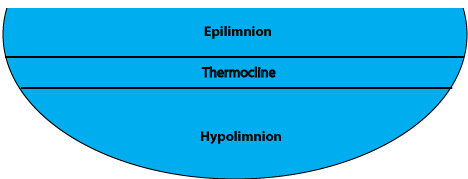Sunset Lake and Turnover
As water temperatures in Sunset Lake begin to drop during fall, some drastic changes occur. These changes all have to do with water density. Water has the strange property of being the least dense (lightest) when it is frozen. This is why ice floats in our drinks. Any warmer than 32 degrees and water becomes more dense (heavier) until it hits 39 degrees. At 39 degrees water is as dense as it can be, any warmer or cooler and it becomes less dense. This plays an important role in our lakes and creates a process called turnover.
What is Turnover?
Turnover occurs in lakes in both fall and spring, and is basically the upper and lower layers of water in a lake mixing together. In summer, Sunset Lake is organized by bands of water that are seperated by temperature. This is called thermal stratification. The top band is called the epilimnion and is a warm layer often moved by wind. The water in this band is all the same temperature. The middle band is called the thermocline and holds water whose temperature varies with depth. The thermocline is an invisible wall which keeps the bands of water above and below it from mixing. The bottom band is called the hypolimnion and holds cool, stagnant water which is all the same temperature. Sunset Lake seperates into these bands because its water is different temperatures and therefore different densities.

In fall, the epilimnion (top band) cools and its temperatures become like those of the hypolimnion (bottom band). Once the two bands of water have similar temperatures and densities, the thermocline (middle band) disappears and wind is able to mix all the water together. This mixing is important because it adds oxygen to the deeper water, in which many creatures will need to spend the winter.
In winter, the water seperates into layers again, this time with cooler water in the epilimnion (top layer) and warmer water in the hypolimnion (bottom layer). When the ice melts in spring and warms up to 39 degrees, the water will again be able to mix and spring turnover will occur.
The dark blue lines in the diagram below represent the thermocline.
Learn more: Water on the Web
